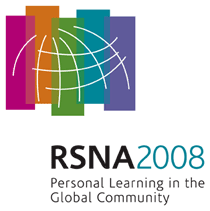
Abstract Archives of the RSNA, 2008
LL-MK4323-B07
Diagnosis of Early-stage Rheumatoid Arthritis: Usefulness of Unenhanced and Gadolinium-enhanced MR Images at 3T
Scientific Posters
Presented on November 30, 2008
Presented as part of LL-MK-B: Musculoskeletal
Hodaka Ohki, Presenter: Nothing to Disclose
Takatoshi Aoki MD, Abstract Co-Author: Nothing to Disclose
Satoshi Kawanami MD, Abstract Co-Author: Nothing to Disclose
Yoshiko Yamnashita MD, Abstract Co-Author: Nothing to Disclose
Shinsaku Yamaguchi, Abstract Co-Author: Nothing to Disclose
Yukunori Korogi MD, Abstract Co-Author: Nothing to Disclose
Earlier diagnosis for rheumatoid arthritis (RA) is important, because the recent papers have shown the effectiveness of early aggressive therapy to prevent irreversible joint damage. Although the revised criteria by American College of Rheumatology (ACR) in 1987 reach a sensitivity of 90% for the patients with the disease duration of several years, the criteria are insufficient for early diagnosis of RA (sensitivity 50-70%). The aim of this study is to assess the diagnostic ability of MR imaging at 3T for the early-stage RA and to establish which unenhanced sequence is useful for the diagnosis of early RA.
Forty-one consecutive patients with polyarthralgia including wrist joint were evaluated with 3T MRI as possible early-stage RA; all patients had no radiographic evidence of RA, and not fulfilled the ACR criteria at the MR examination. Four unenhanced images and a postcontrast T1-weighted image of the hands were obtained in each patient. Unenhanced imaging protocol included T2-weighted fast spin-echo (FSE) sequence, gradient-recalled-echo sequence, fat-suppressed intermediate-weighted FSE sequence, and fast imaging employing steadystate acquisition (FIESTA) sequence. After prospective follow-up of more than 1 year, the diagnosis of RA was determined by the ACR criteria.
Finally, 21 of 41 patients fulfilled the ACR criteria (definite RA). Synovitis was detected with postcontrast MRI in all 21 patients (100%) at the initial stage. Among the four unenhanced sequences, the fat-suppressed intermediate-weighted FSE showed the highest detection rate (14/21=67%) of synovitis in early RA; early RA patients had significantly higher positive finding of synovitis than non-RA patients. The FIESTA images also demonstrated the synovitis and bony erosion clearly in more than half of early RA patients.
Postcontrast T1-weighted MR image at 3T was useful for predicting the patients with early-stage RA. Among the unenhanced MR images, fat-suppressed intermediate-weighted FSE image and FIESTA image were effective for diagnosis of early-stage RA.
MR imaging at 3T may be a powerful tool for discriminating and managing early-stage RA patients. 3T MRI seems also useful for the patients with contraindications to administration of gadolinium.
Ohki, H,
Aoki, T,
Kawanami, S,
Yamnashita, Y,
Yamaguchi, S,
Korogi, Y,
Diagnosis of Early-stage Rheumatoid Arthritis: Usefulness of Unenhanced and Gadolinium-enhanced MR Images at 3T. Radiological Society of North America 2008 Scientific Assembly and Annual Meeting, February 18 - February 20, 2008 ,Chicago IL.
http://archive.rsna.org/2008/6009442.html

